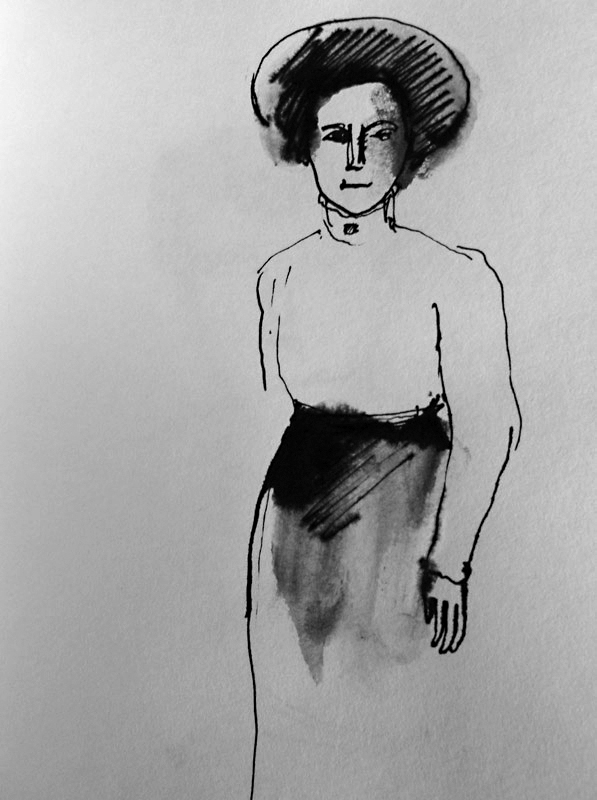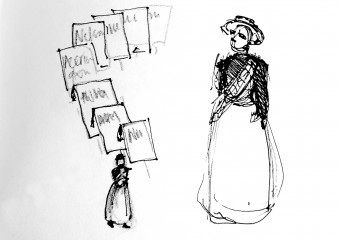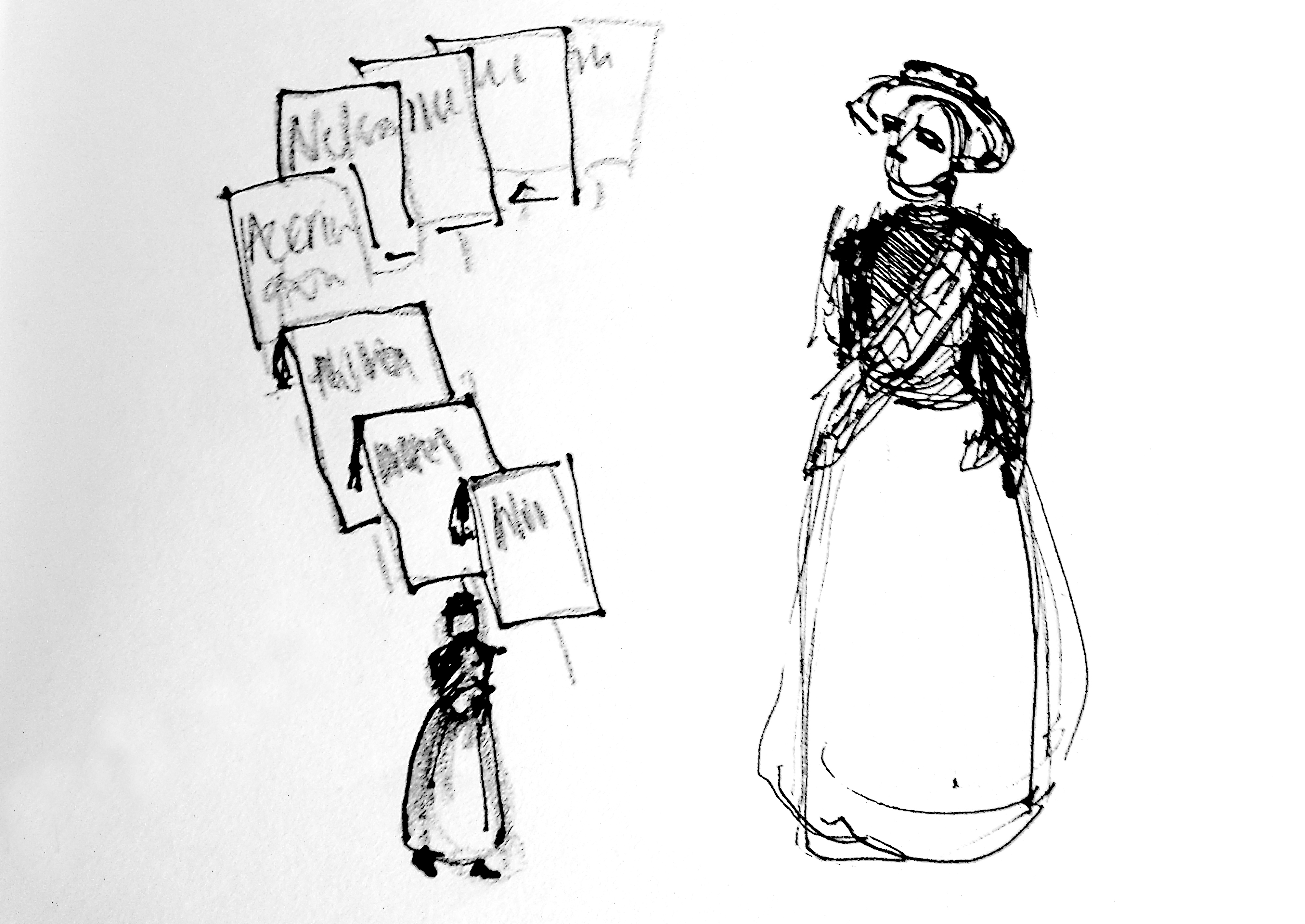‘Only in freedom is permanent peace possible’ – Catherine Marshall, May 1919 [1]
 It must have been a strange sight: the ex-suffragette leading a proccession of soldiers four-abreast down Whitehall, under the banner ‘Lift the Hunger Blockade!’ [2]
It must have been a strange sight: the ex-suffragette leading a proccession of soldiers four-abreast down Whitehall, under the banner ‘Lift the Hunger Blockade!’ [2]
The Women’s International League (WIL) [3] had announced a demonstration in Trafalgar Square, against the continuing blockade of Germany and Austria-Hungary, to take place on 6 April 1919 [4], and ‘one of the most bellicose daily papers had launched an advance attack on the event, ‘call[ing] upon soldiers to come and break it up’.[5]
They turned up in force, but the paper had failed to reckon with the persuasive powers of the speakers, including the veteran feminist and anti-war campaigner Emmeline Pethick-Lawrence. [6]
A resolution to end the blockade was passed with enthusiasm by the ten-thousand-strong crowd, who then demanded to know what would be done with it. [7] ‘I will take it to Downing Street if the army will come with me,’ Pethick-Lawrence replied, and they agreed to join her. [8]
‘Until the Germans learn a few things’
In place since 1914, Britain’s illegal [9] naval blockade of Germany ‘sought to starve the whole population – men, women and children, old and young – into submission’ (Churchill) [10], and may have been responsible for as many as ¾ million deaths during the war. [11]
After the armistice was signed on 11 November 1918, ‘[t]he blockade was maintained strictly until March [1919] and more leniently until July, leading to perhaps a quarter of a million civilian deaths.’ [12] ‘British officials took the view that they didn’t want to relax the blockade “until the Germans learn a few things”‘. [13]
Others saw matters differently – and not just about the hunger blockade. Indeed, many of those who had struggled to end the war now turned their attention to other causes, including disarmament [14], Western military intervention in the Soviet Union [15], and the struggle against fascism. [16]
A preventable catastrophe?
According to historian C. Paul Vincent, ‘German expansionist dreams might not have received unsuspected encouragement had the Allies promoted, during the postwar period, a sense of goodwill with the Germans’. [17]
Nonetheless, though it may be true that ‘the Second World War would have been inconceivable without the First [18], the earlier war did not lead inevitably to the later. [19]
Indeed, Noam Chomsky has even speculated that the Second World War could have been prevented as late as 1938, but wasn’t ‘mainly because Britain and the United States weren’t that much opposed to [Hitler].’ [20]
NOTES
 [1] Anne Wiltsher, Most Dangerous Women, Pandora, 1985, p. 210. Other sources attribute the quote to the US peace activist Jane Addams.
[1] Anne Wiltsher, Most Dangerous Women, Pandora, 1985, p. 210. Other sources attribute the quote to the US peace activist Jane Addams.
[2] Emmeline Pethick-Lawrence, My Part in a Changing World, Gollancz, 1938, p. 325.
[3] The Women’s International League was the British section of the International Commitee of Women for Permament Peace (ICWPP), the international peace group established at the 1915 Women’s International Congress at the Hague (Wiltsher, op. cit., pp. 126, 131).
[4] Jill Liddington, Long Road to Greenham, Virago, 1989, p. 136.
[5] Pethick-Lawrence, op. cit. WIL’s new national secretary, Ayrton Gould, was unable to attend the May 1919 Women’s International Congress in Zurich, as she had to appear in court for failing to submit the leaflet distributed at the 6 April demo – which featured a photograph of severely emaciated Austrian children – to the censor. (Wiltsher, op. cit., pp. 204 – 205; Katherine Storr, Excluded from the Record: Women, Refugees, and Relief, 1914-1929, Peter Lang, 2009, p. 244). A second activist, Eglantyne Jebb – who had co-founded the Fight the Famine Council, launched on 1 January 1919, and would go on to launch the Save the Children Fund in May 1919 – was also prosecuted (ibid.; Liddington, op. cit., p. 135 – 136). Wiltsher writes that, as a result of the 6 April demo ‘WIL had managed to collect one million rubber teats to send to German mothers unable to nurse their babies because of their own malnutrition’ (Wiltsher, op. cit., p. 205), but she appears to have the chronology confused here – see Storr, op. cit., p. 243.
[6] Among other things Pethick-Lawrence helped devise the suffragette’s famous purple, white and green regalia, and, in her capacity as its treasurer, helped to raise over £90,000 (£8m in today’s money) for the Women’s Social and Political and Union (WSPU), whose paper (Votes for Women) she also edited along with her husband Frederick (June Purvis, Emmeline Pankhurst: A Biography, Taylor and Francis e-Library, 2005, p. 107; Martin Pugh, The March of the Women: A Revisionist Analysis of the Campaign for Women’s Suffrage, 1866 – 1914, Oxford University Press, p. 218; Elisabeth Crawford, The Women’s Suffrage Movement: A Reference Guide 1866-1928, pp. 537 – 8, 540. The £90,000 figure is a lower bound, obtained by summing the figures in Pugh for the the years 1907/08, 1908/09, 1909/10 amd 1910/11; the conversion to 2013 values uses a (conservative) conversion factor of 88.86 taken from www.measuringworth.com). Jailed and force-fed for her suffrage activism, in late 1914 she travelled to the US, where she spoke out against the war – including at a meeting in Chicago with Rosika Schwimmer – before becoming one of only three British women to attend the Women’s International Congress at the Hague in April / May 1915 (Paula Bartley, Emmeline Pankhurst, Routledge, 2002, p. 132; Wiltsher, op. cit., pp. 49 – 53, 96).
[7] Liddington, op. cit., p. 136; Pethick-Lawrence, op. cit.
[8] Ibid. In Germany public meetings held by the ultra-patriotic Fatherland Party during the war ‘became the focus for bitter political disputes between far right nationalists and veterans from the Front who argued that war was from from glorious’, leading to the Party ‘call[ing] on the police to prevent disruptive veterans from attending their meetings’ (Jon Lawrence, ‘Public space, political space’, p. 290 in Jay Winter & Jean-Louis Robert, Capital Cities at War: Paris, London, Berlin, 1914 – 1919 vol.2, Yale University Press, 1992).
[9] Stephen Shalom, Imperial Alibis, Southend Press, 1993, p. 119.
[10] Nicholson Baker, Human Smoke: The Beginning of World War II, the End of Civilisation, Simon and Schuster, 2008, p.2, citing Churchill’s post-war book The World Crisis.
[11] C. Paul Vincent, The Politics of Hunger: The Allied Blockade of Germany, 1915 – 1919, Ohio University Press, 1985, p. 141. This figure – which excludes deaths from the 1918 flu pandemic, the total of which was undoubtedly boosted by the blockade – was calculated by the German National Health Office at the close of the war. Drawing attention to the ‘peculiar’ manner in which this figure was calculated, Vincent writes that, while it may be too high, ‘there is no question that the vast increase in civilian mortality after 1914 was largely attributable to the blockade’ (ibid., p. 145). The death rate of children between the ages of one and five rose by fifty percent during the war, with rickets becoming ‘commonplace’ among the survivors (ibid., pp. 137, 139, 146).
[12] David Stevenson, 1914 – 1918: The History of the First World War, Penguin, 2005, p. 512.
[13] Shalom, op. cit.
[14] The Women’s International League for Peace and Freedom – which replaced the International Committee of Women for Permanent Peace established at the 1915 International Women’s Congress at the Hague – collected over six million signatures calling for disarmament, in advance of the ill-fated World Disarmament Conference in 1932 (Wiltsher, op. cit., p. 212).
In 1932 (ie. pre-Hitler), at the League of Nations’ World Disarmament Conference, Germany ‘proposed a prohibition on the use and manufacture of chemical and bacteriological weapons, as well as the abolition of tanks, heavy artillery and conscription’, as well as a ‘total prohibition of bombing’, but the proposals were not adopted (Joshua Adams, ‘Women take on the world disarmament conference’, http://armingallsides.on-the-record.org.uk; Sven Linqvist, A History of Bombing, Granta, 2001, section 140). For one thing, Britain insisted upon exempting bombing for ‘police purposes in certain outlying regions’ (ibid.). ‘[W]e insisted on reserving the right … to bomb niggers!’, Lloyd George later observed to his second wife Frances Stevenson (AJP Taylor (ed) & Frances Stevenson, Lloyd George: A Diary, Hutchinson & Co, 1971, p. 259. The full quote, which appears in Stevenson’s diary entry for 9 March 1934, is: ‘At Geneva other countries would have agreed not to use aeroplanes for bombing purposes, but we insisted on reserving the right, as D. puts it, to bomb niggers!’). According to David Stevenson, Britain’s repression of the 1920 rebellion in Iraq – which killed over 8,000 people – ‘cost more than all of Britain’s wartime operations in the Middle East’ (Nicholson Baker, Human Smoke: The Beginning of World War II, the End of Civilisation, Simon and Schuster, 2008, p.8; Stevenson, op. cit., p. 540).
For more info and background see Adams, op. cit.
[15] In August 1920, in the wake of the successful refusal by London dock workers to load the SS Jolly George ‘with British armaments bound for Poland to be used by Russia’s anti-Bolshevik White Armies’, the Labour Party and trade unions warned the British Government that ‘any attempt to intervene militarily in the war between Poland and the Soviet Union would be met by a general strike’ – a threat that ‘may have proved decisive in preventing British involvement in [that] war’ (Laura Forster and Patricia Wheeler, ‘Hands Off Russia! Movement’, http://armingallsides.on-the-record.org.uk; Douglas Newton, British Labour, European Socialism and the Struggle for Peace, 1889 – 1914, Oxford University Press, 1985, p. 355).
[16] For example, two veterans of the Women’s Peace Crusade, Charlotte Despard and Selina Cooper became leading members in the late 1930s Communist-backed ‘Women Against War and Fascism’ (Wiltsher, op. cit., p. 213). In 1934, Cooper – who had taken part in WILPF’s 1926 Peacemakers Pilgrimmage for disarmament and international arbitration – had travelled to Nazi Germany in an unsuccessful attempt to secure the release of the wives of several prominent communists, who were being held hostage by the Nazis (Jill Liddington, The Life and Times of a Respectable Rebel, pp. 406 – 407, pp. 412 – 415).
[17] Vincent, op. cit., p. 150.
[18] Stevenson, op. cit., p. 503. According to Stevenson, ‘the war was essential to the Nazi takeover not only through its contribution to the economic crisis but also through its role in reawakening German nationalism as the memory of 1914 – 18 was re-evaluated.’ (ibid., p. 570). In a similar vein, Ian Kershaw writes that, ‘The First World War made Hitler possible … without the trauma of war, defeat and revolution, without the political radicalization of German society that this trauma brought about, the demagogue would have been without an audence for his raucous, hate-filled message … Without the war, a Hitler on Chancellor’s seat that had been occupied by Bismarck would have been unthinkable’ (Ian Kershaw, Hitler 1889 – 1936: Hubris, Penguin, 2001, p. 73).
But possibility is not inevitability. According to Stevenson – who notes that despite Germany’s attempts to circumvent the disarmament clauses of the Treaty during the ’20s, German defence spending was still less than 1% of its national income when Hitler came to power – the Versailles Treaty ‘could have stopped another bloodbath if it had been upheld.’ (Stevenson, p. 529). However – again according to Stevenson – the task of treaty enforcement fell ‘mainly on Britain and France’, who had divergent interests (ibid., p. 532). For example, ‘the British wanted to see German economic recovery’, and in the 1920s were still preparing to deter a French attack, approving a bomber construction programme in 1922 ‘as a deterrent against a French air threat to London.’ (Stevenson, op. cit., pp. 532, 536). Three years later these preparations were still apparently a live issue, with the head of the RAF, Sir Hugh Trenchard, offering the opinion that ‘the French in a bombing duel would probably squeal before we did.’ (A. C. Grayling, Among the Dead Cities, Bloomsbury, 2006, p. 131).
[19] Here we disagree with Adam Hochschild, who writes that the First World War ‘virtually guaranteed the one that would begin in 1939’ (Adam Hochschild, To End All Wars, MacMillan, 2011, p. 372).
[20] ‘On War and Activism: Noam Chomsky interviewed by Charngchi Way’, 9 December 2005, http://www.chomsky.info/interviews/20051209.htm. According to Chomsky, ‘The rise of fascism in the interwar period elicited concern, but was generally regarded rather favourably by the US and British governments, the business world, and a good deal of elite opinion. The reason was that the fascist version of extreme nationalism permitted extensive Western economic penetration and also destroyed the much-feared labor movements and the left …’ (Noam Chomsky, Hegemony or Survival, Metropolitan Books, 2003, p. 67).
Thus, in 1927 Churchill claimed that Italian fascism had provided the ‘necessary antidote to the Russian virus’, while ‘the American chargé d’affaires in Berlin wrote to Washington in 1933 that the hope for Germany lay in “the more moderate section of the [Nazi] party, headed by Hitler himself . . . which appeal[s] to all civilized and reasonable people,” and seems to have “the upper hand” over the violent fringe. “From the standpoint of stable political conditions, it is perhaps well that Hitler is now in a position to wield unprecedented power,” noted the American Ambassador, Frederic Sackett.’ (Baker, op. cit., p. 16; Peter R. Mitchell and John Schoeffel (eds) and Noam Chomsky, Understanding Power: The Indispensable Noam Chomsky, Vintage, 2003, chapter 5, footnote 19, available online at: http://www.randomhousesites.co.uk/understandingpower/chap5.htm).
In a similar vein, ‘a 1937 Report of the State Department’s European Division described the rise of Fascism as the natural reaction of “the rich and middle classes, in self-defense” when the “dissatisfied masses, with the example of the Russian revolution before them, swing to the Left.” Fascism therefore “must succeed or the masses, this time reinforced by the disillusioned middle classes, will again turn to the Left.” The Report also noted that “if Fascism cannot succeed by persuasion [in Germany], it must succeed by force.”‘ (ibid.).
Moreover, a study based on declassified British government sources, has apparently revealed a ‘secret British deal allowing Hitler free rein to expand in Eastern Europe; this deal was “motivated by anti-communism” and was “not a sudden policy quirk but was the crowning of incessant efforts to encourage Japan and Germany ‘to take their fill’ of the Soviet Union”‘ (ibid., citing Clement Leibovitz, The Chamberlain-Hitler Deal, Edmonton, Canada: Les Éditions Duval, 1993, p. 6). ‘Leibovitz’s study also establishes conclusively, from a wide variety of sources, that there was great sympathy for Hitler’s and Mussolini’s policies among the British establishment.’ (ibid.).
Meanwhile, ‘Many U.S. companies bought substantial interests in established German companies, which in turn plowed that new money into Aryanizations or into arms production banned under the Versailles Treaty. According to a 1936 report from Ambassador William Dodd to President Roosevelt, a half-dozen key U.S. Companies – International Harvester, Ford, General Motors, Standard Oil of New Jersey, and du Pont – had become deeply involved in German weapons production…’ (Christopher Simpson, The Splendid Blonde Beast, Common Courage Press, 1995, p. 64).
‘U.S. investment in Germany accelerated rapidly after Hitler came to power, despite the Depression and Germany’s default on virtually all of its government and commercial loans. Commerce Department reports show that U.S. investment in Germany increased some 48.5 percent between 1929 and 1940, while declining sharply everywhere else in continental Europe.’ (ibid.).




